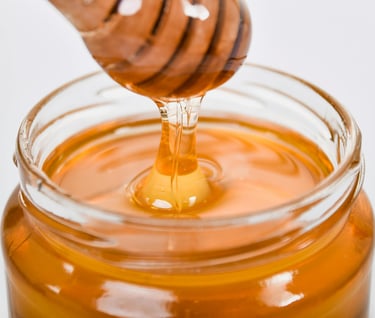Honey: The Most Misused “Health Food” and What Ayurveda Really Says About It
HEALTH & WELLNESSWELL-BEINGEDITOR'S PICKS
Amit Gupta, MD
11/21/20253 min read


Dr. Amit K. Gupta, MD (Ayurveda practitioner and physician) is the founder of CureNatural, where classical Ayurvedic wisdom meets modern living. To learn more about Ayurveda and how to integrate it into your life, visit CureNatural.
Honey has earned its place in every kitchen as the natural sweetener of choice. People add it to tea, drizzle it on toast, and blend it into smoothies thinking it’s a healthy alternative to sugar. Ayurveda agrees that honey can be deeply healing, but only when it’s used correctly. When it’s not, that same honey can quietly do more harm than good.
In Ayurveda, honey is considered a natural medicine, not just a sweetener. Ancient texts describe honey as having unique carrier properties, meaning it carries the qualities of whatever it’s mixed with deeper into the body. That’s why honey is often used to deliver herbs more effectively. But with that potency comes responsibility in how it’s used.
The most common mistake people make is heating honey. According to Ayurvedic tradition, when honey is exposed to high heat - whether mixed into boiling tea, baked in desserts, or added to hot water - its structure changes and becomes difficult to digest. Modern research supports this observation. When honey is heated above roughly 60 °C (140 °F), it begins forming 5-hydroxymethylfurfural (HMF), a compound that increases with temperature and time. In moderate amounts HMF may have antioxidant effects, but higher concentrations have been shown in animal and cell studies to cause oxidative and renal stress.
This is where temperature makes all the difference. Warm water (below body temperature, about 40 °C / 104 °F) does not significantly increase HMF or denature honey’s enzymes, whereas hot water or boiling liquids accelerate chemical breakdown and HMF formation, degrading quality and digestibility. So when Ayurveda warns not to heat honey, it’s not superstition. It reflects the same biochemical reality modern food science now measures.
The second misuse is quantity. Honey is not meant to be eaten like jam. A teaspoon is medicine; a tablespoon is indulgence. It’s dense, heavy, and heating in nature. When used properly, it helps balance sluggish metabolism and supports energy while reducing excess mucus. But overused, it can promote inflammation or dryness depending on the individual constitution.
Here’s how to use honey the right way:
Never heat it. Add honey only after your tea or water has cooled to a warm or room temperature.
Use raw or unprocessed honey. Filtered or pasteurized honey loses much of its natural enzymes and vitality.
Pair it wisely. Honey combines beautifully with herbs like turmeric, ginger, cinnamon, and tulsi. A small mixture of honey and turmeric can support digestion, while honey and ginger can help clear congestion.
Use small amounts. A little goes a long way.
Avoid mixing with ghee in equal parts. Though popular online, this equal mixture is considered incompatible in traditional guidance.
Ayurveda also individualizes honey use. For heavier body types prone to sluggishness or congestion, honey in small amounts with ginger or cinnamon can be energizing. For those who overheat or experience acid reflux, use it sparingly with cooling herbs like cardamom. For those who run dry or anxious, a small amount with warm milk or ghee can be grounding, but never in excess.
What makes honey so special is not just its chemistry but its intelligence. It is said to absorb the qualities of the flowers the bees visit, becoming a reflection of the ecosystem itself. It’s nature’s alchemy in a jar, but only when we treat it with care.
The modern wellness world often takes a “more is better” approach. Ayurveda offers a humbler lesson: even the purest natural ingredient can lose its magic if we forget the context. Honey is a reminder that health is not in a single superfood, but in how we align with nature’s rhythm.
So the next time you sweeten your tea, let it cool a bit first. Stir in that spoonful of golden honey with intention. It’s a small ritual, one that connects you to centuries of wisdom and to the quiet intelligence of the bees that made it.
